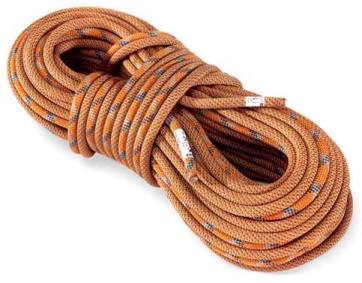The most common rope is a 60 meter long dry rope with a 9.8mm - 10.2mm diameter, a verg good all-around rope that will work for many situations. But there are ropes made for every type of climbing.
- Rescue
- Sport climbing
- Big walls
- Alpine
- ...
Types of Rope (General guidelines.)
Static Ropes 9-13mm (commonly 7/16" and 1/2" diameter)
These excel in situations where you don't want the rope to stretch.
Ideal uses: Rappelling, rescue and big-wall ascending-anytime you are lowering, ascending or pulling a load up with the rope.
Shortcomings: Not to be used for climbing as these ropes are not designed, tested nor certified for those types of loads.
Workhorse Singles 10.1-11mm, 65-77 g/m
A workhorse rope is one that will hold up to lots of use and abuse. It is good for routes with rough rock and edges. In conjunction with a thicker sheath, a fat rope will give you the most sharp-edge protection. Its larger diameter makes it easier to hold onto and less likely for a belayer to drop the climber; though it's less smooth with some belay devices.
Ideal uses: Big walls, top roping, working sport routes, extreme use.
Shortcomings: Heavy and big in your pack.
All-Around Singles 9.5-10mm, 60-64 g/m
They are the ones most people will buy, because they are of average diameter, weight and fall ratings. Not too light, nor too heavy. They are the do-everything, go-to ropes.
Ideal uses: Sport, trad, alpine.
Shortcomings: Not much, unless you are specializing in fast and light or thrashing up a big wall.
Skinny Singles 8.9-9.4mm, 52-59 g/m
Their light weight makes a big difference. Think long routes where you are turning over many belays or in an alpine setting where you are coiling most of the rope over your shoulder. Hard sport routes are also a great place to use this kind of rope. Be sure you can catch a fall with your skinny rope. Use a complementary belay device designed for skinny rope (preferably with a friction groove).
Ideal uses: Fast and light for onsights and redpoints at your limit.
Shortcomings: More risk of rope cutting over an edge. More difficulty in catching a fall-make sure you have a belay device that offers maximum friction and is rated for the diameter of your rope.
Half Ropes 8-9mm, 41-53 g/m
These are a great option for long, wandering routes. Whether on rock, ice or mixed, half ropes offer many advantages. When it comes time to rappel, you can go twice as far by tying the two ropes together. And lastly, two strands of rope reduce the odds of your lifeline being severed either from a leader fall over an edge or from rockfall.
Ideal uses: Wandering multi-pitch rock or alpine routes that you will need to rappel or might have to retreat part-way through.
Shortcomings: More time and energy consuming to use due to the extra bulk and weight with two strands and while managing belay transitions.
Twin Ropes 7-8mm, 37-42 g/m
Another great two-rope that is lighter and less bulky than half ropes. You can still rappel twice as far, like with half ropes.
Ideal uses: Ice climbs and non-wandering rock climbs where rappelling is in the cards.
Shortcomings: You have to clip both strands ALWAYS through each piece of protection, so there will be more rope drag than with half ropes.
Avoid:
- Contact with chemicals, acids, alkalis, bleach, oxidising agents (present in concrete).
- Keep rope off the ground to protect it from dirt which can work into the fibers where sharp crystals can cut the rope fibers.
- Embers, sparks or other sources of ignition.
- Too much UV rays (sun), can considerably weaken your rope.
- Treading on rope as this may work sharp particles into the core.
- Nylon on nylon, this contact burns rope and webbing.
- Running two ropes through the same top-rope carabiners, and never run a top rope directly through slings.
- High impact loads, such as long practice falls, fast or jerky rappelling.
Life Expectancy:
Inspect your rope often. You should be looking and feeling every inch of it for cuts, nicks and abrasions in the sheath, and for sections of mushy or flat core.
Replacement Schedule:
- Heavy sport climbing use with repeated falls: 3-6 months
- Heavy trad climbing use with few falls: 1-2 years
- Weekends: 2-3 years
- Occasional use: 4-5 years
- Huge falls, flat spots, soft spots, becoming stiff, sheath damage or other damage: immediately!
How long you decide to use the rope depends on your own inspection, knowledge of the rope's history, and assessment. Repeated minor falls, heat from rapid rapelling, and rapelling using small diameter carabiners all tend to weaken rope.

